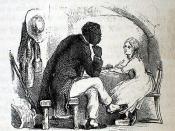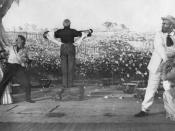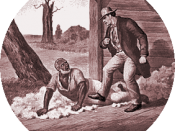The exhibition at the New-York Historical Society includes 25 different early editions of the novel, abolitionist pamphlets, proslavery books, six sculptural figure groups depicting scenes from the book and six crayon studies titled The End of Uncle Tom and the Grand Allegorical Tableau of Eva in Heaven (1995).
From the very beginning, 150 years ago, Uncle Tom's Cabin has has evolved from an early abolitionist touchstone to a controversial source of racist stereotypes and more. The New-York Historical Society exhibit examines the complex history of the novel.
I think the main purpose for Harriet Beecher Stowe to write this novel was to say what she felt had to be said and that everyone was to afraid to say. She didn't care that people might think of her as "un-lady like" for speaking out. She said something to the essence of: There comes a point when a person can no longer be silenced on topics that need to be heard.
Although criticized for misrepresenting black people in her novel, I think that Stowe's book serves its purpose well; The purpose being, in my opinion, to speak out against slavery and to devalue those who support it.
In the exhibit there were many cartoons and advertisements. One advertisement has an old man hunched over working in the garden behind his restaurant, he is wearing rags appears to be tired. In the back ground you see a poster advertising his restaurant. In the poster he is young and is standing upright holding a plate of steaming food. The purpose of this drawing is to show that society has distorted Uncle Tom's character to be more heroic and righteous than he really is, just like the poster shows the old man young and handsome.
"Topsy and Miss Ophelia" (1880, Theater poster) This poster portrays...


